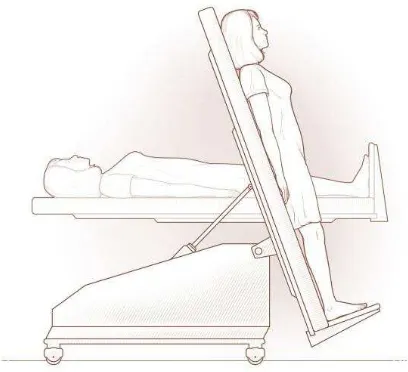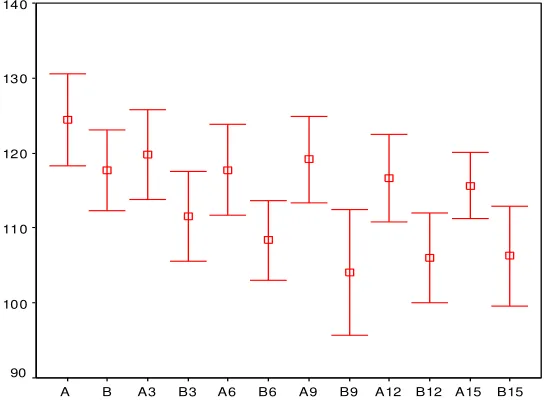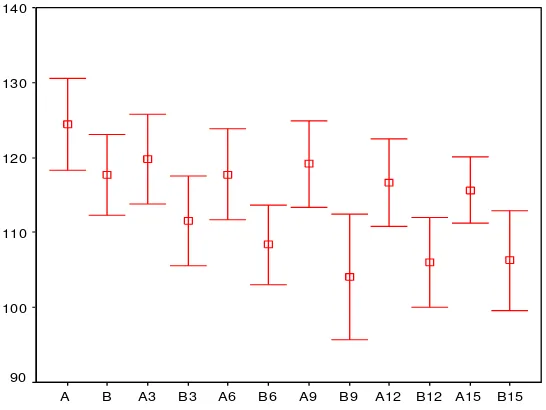Potential use of isosorbide dinitrate
As a new drug for tilt table test of young adult subject:
A study of haemodynamic effects
Yoga Yuniadi, Erika Maharani, Radityo Prakoso, Robert E Saragih, Muhammad Munawar
Abstrak
Sinkop vasovagal merupakan masalah kesehatan yang sering didapatkan pada populasi dewasa muda. Tilt table test (TTT) merupakan satu-satunya metoda diagnosis sinkop vasovagal. Isoprenalin yang merupakan obat baku yang digunakan pada TTT saat ini sulit sekali didapatkan di Indonesia, oleh karena itu kami melakukan studi hemodinamik dari isosorbide dinitrate (ISDN) yang merupakan alternative bagi isoprenaline karena memiliki cara kerja yang serupa melalui penimbunan darah di vena. Sebanyak17 orang dewasa muda yang sehat (rerata umur 28.6 4.7 tahun, dan pria 14 orang) menjalani TTT dengan memakai ISDN 400 μg disemprotkan sublingual sebagai obat provokatif. Perubahan hemodinamik yang terjadi selama fase dasar dan provokatif diukur. Tidak satupun dari 17 subyek yang mengalami sinkop. Sekalipun terdapat penurunan bermakna pada tekanan darah sistolik, diastolik dan tekanan rerata arteri serta peningkatan bermakana laju jantung, akan tetapi perubahan-perubahan itu tidak cukup bermakna untuk menyebabkan sinkop. Kesimpulannya pemberian ISDN semprot sublingual pada populasi dewasa muda sehat yang menjalani TTT menyebabkan perubahan hemodinamik yang bermakna tetapi tidak menimbulkan sinkop. Hasil penelitian ini dapat menjadi dasar bagi penggunaan ISDN sebagai obat provokatif pada TTT. (Med J Indones 2006; 15:24-9)
Abstract
Vasovagal syncope is a common health problem in young adult population. Tilt table test (TTT) is the only method to diagnose vasovagal syncope. Since isoprenaline as a standard provocative drug of TTT is hard to be found in Indonesia, we study the haemodynamic effect of isosorbide dinitrate (ISDN) which has similar venous pooling effect with isoprenaline. Seventeen young healthy adult subjects (age of 28.6 4.7 year old, and 14 males) underwent TTT using 400 μg ISDN spray sublingually as a provocative drug. The haemodynamic changes were observed during baseline and provocative phase. None of 17 subjects experienced of syncope. Although, the systolic, diastolic, and mean arterial blood pressure were significantly decreased and the heart rate significantly increased after ISDN administration, but the changes were not sufficient to cause syncopal event. In conclusion sublingual ISDN spray during TTT of young healthy adult subject changes haemodynamic measures but did not cause syncope. These results give a reasonable basic for ISDN usage as provocative drug of TTT. (Med J Indones 2006; 15:24-9)
Keywords: Syncope, vasovagal, tilt table test, nitrate
Syncope, which is a common medical problem, may be benign or may be the only warning before an episode causing sudden death.1 More than 40% of syncope patients in clinics were neurally mediated syncope.2 Neurocardiogenic (vasovagal) syncope is the most common of neurally mediated syncope, characterized by a sudden failure of the autonomic nervous system to maintain blood pressure and
sometimes heart rate at a level sufficient to maintain cerebral perfusion and consciousness.3
Tilt-table testing (TTT) is the only method for the diagnosis of neurocardiogenic syncope.4 Nowadays, isoprenaline is the standard drug to be used during TTT.5 However, isoprenaline is very difficult to be found in Indonesia, not only in remote area even in a big city like Jakarta. Isosorbide dinitrate (ISDN) is though to be an alternative to isoprenaline since it has the same venous pooling effect with small dose of isoprenaline. However, the results of ISDN administration during TTT are still contradictive. In the other hand, the haemodynamic effect of ISDN administration Department of Cardiology and Vascular Medicine, Faculty of
during TTT has not been elucidated widely, especially in normal young adult subject. Since ISDN is widely distributed in all over this country, it has a potential benefit to be used as a replacement drug for isoprenaline. We performed this study to give reasonable basic of ISDN usage for TTT purposes.
METHODS
Seventeen healthy young adult subjects (mean age of 28.6 4.7 year old, male 14) without history of syncope were enrolled in this study. All respondents underwent physical examination and 12 lead ECG recording. Subjects with history of cardiovascular disease, consumed cardio-active drug, or having neurological problem were excluded. The eligible subjects under-went TTT during 4 hours fasting condition and intravenous line inserted. Continues ECG monitoring of biphasic defibrillator (Heartstart XL, Philips) and automatic digital sphygmomanometer (Dinamap Procare 100, General Electric) were used during TTT.
TTT protocol
The protocol of TTT has been published elsewhere.5 In brief, it consists of baseline and provocative phase. The subject lies down in supine position on tilting radiological table and tied up with soft band to keep the body on the table in occurrence of syncope. The baseline phase starts with supine pre-tilt phase lasting for 10 minutes. The heart rate and blood pressure were measured every 3 minutes. Then, the table was tilted of 70 degree for another 15 minutes and again the heart rate and blood pressure measurement were performed every 3 minutes. After completed the baseline phase, the test proceeded to the provocative phase. In provocative test, 400 μg (2 puff) ISDN was sprayed sublingually during upright position and then underwent 20 minutes observation by measuring the blood pressure and heart rate every 3 minutes. The endpoint of TTT was episode of syncope or presyncope characterized by sudden abrupt of heart rate and/or blood pressure at anytime along the procedure. A cardiology resident and a nurse supervised the TTT procedure. (Figure 1)
Definition
Syncope was defined as a sudden and transient loss of consciousness and of postural tone with spontaneous recovery.6 Presyncope was defined as nearly syncope state.
Figure 1. Illustration of tilt table test. The subject lies down on the tilting table, tied up with a soft band and then the table is tilted up to 70 degree. Heart rate and blood pressure are measured every 3 minutes.
ISDN spray that was used in this study comes from Mack (Isomack®).
Mean arterial pressure (MAP) was defined as the sum of systolic blood pressure with twice of diastolic blood pressure and then divided by 3.
Statistical analysis
Statistical analysis was done using SPSS 11 program. Continues variable were presented as mean SD. The differences between blood pressure and heart rate of baseline and provocative phase were tested by paired t-test. P value of < 0.05 was considered statistically significant.
RESULTS
B15 A15 B12 A12 B9 A9 B6 A6 B3 A3 B A 14 0
13 0
12 0
11 0
10 0
90
of bellow 100 mmHg. A greater decline demonstrated in diastolic pressure measurements during provocative test as compare to that during baseline, which are about 4 – 16 mmHg. The mean arterial pressure (MAP) values along the test ranged from 75.7 – 95.8
mmHg. The MAP of provocative phase 3 minutes after ISDN administration were significantly different compare to that during baseline tilted position (p < 0.001 for all time of measurements). The mean difference of MAP was about 12 mmHg. (Figure 3)
Figure 2. The diagram shows changes of systolic blood pressure (SBP) from tilting position of baseline phase (A) to provocative phase (B) with ISDN administration. A represents a mean measurement (heart rate) immediately after tilting position of baseline phase, A3 represents a mean measurement of 3 minutes after tilting of baseline phase, A6 is 6 minutes measurement of tilting baseline phase, etc. B represents a mean measurement immediately after ISDN administration; B3 represents a mean measurement of 3 minutes after ISDN administration, etc. Bars limits represent 95% CI.
Table 1. Haemodynamic Measurements
Time
Baseline ISDN administration P value
HR SBP DBP MAP HR SBP DBP MAP HR SBP DBP MAP
0 789.7 12413 8110 9610 869.3 11811 7810 9110 <0.001 0.019 0.089 0.024
3 777.6 12012 8010 9310 9710 11212 657 817 <0.001 0.003 <0.001 <0.001
6 789.4 11812 807 939 9812 10811 668 809 <0.001 0.001 <0.001 <0.001
9 7810 11912 809 9310 9613.4 10417 6115 7615 <0.001 0.002 <0.001 <0.001
12 788.1 11712 787 919 9116.9 10612 6511 7912 0.001 <0.001 <0.001 <0.001
B15 A15 B12 A12 B9 A9 B6 A6 B3 A3 B A 14 0
13 0
12 0
11 0
10 0
90
Figure 3. The diagram shows changes of mean arterial pressure (MAP) from tilting position of baseline phase (A) to provocative phase (B) with ISDN administration. All present legends have same meaning with that of figure 2.
The heart rate measurements during baseline were significantly different compare to that during provocative test. The heart rate increased during provocative test as compensation to the blood pressure reduction. No evidence of abrupt heart rate reduction to value of below 60 bpm, nor drastic heart rate increment.
DISCUSSION
This study showed that the usage of sublingual ISDN spray during TTT in healthy young adult subject change the haemodynamic parameters but did not provoke vasovagal syncope.
Haemodynamic respons to TTT
In healthy younger individuals with cerebral blood flow in the range of 50–60 ml/100 g tissue/min, that represents about 12 to 15% of resting cardiac output, are easily achieved. Those volume are correlated with minimum oxygen requirements necessary to sustain consciousness (approximately 3·0 to 3·5 ml O2/100 g tissue/min). Cerebral perfusion pressure is largely dependent on systemic arterial pressure. Thus, any factor that decreases either cardiac output or total peripheral vascular resistance diminishes systemic arterial pressure and cerebral perfusion pressure.5 In
similar volume of plasma through dependent capillaries caused by the increased hydrostatic pressure. The overall effect of this stress is to reduce the rate of blood flow returning to the heart and consequently to reduce cardiac output.
Even though, the haemodynamic measures significantly change by nitrate administration, it was not sufficient to induce syncope. The MAP values were about 90.4 – 95.8 mmHg during baseline phase, and 75.7 – 91.3 mmHg during provocative phase. A severe hypo-tension (MAP 50 mmHg) is needed to produce significant hypoxemia. At this level the impulse traffic in the afferents from arterial baroreceptors is considerably reduced, and, consequently, tonic vasoconstrictor sympathetic discharge from the vasomotor center is disinhibited.8 A sudden cessation of cerebral blood flow for 6 to 8 s has been shown to be sufficient to cause complete loss of consciousness.5 Syncope was not occurred because the MAP was maintained above 50 mmHg along the test. It was assumed that in healthy young adult subjects, administration of ISDN during TTT did not impair the integrity of crucial control mechanisms for maintaining adequate cerebral nutrient delivery, including: (a) cerebrovascular ‘autoregulatory’ capability, which permits cerebral blood flow to be maintained over a relatively wide range of perfusion pressures; (b) local metabolic and chemical control which permits cerebral vasodilatation to occur in the presence of either diminished pO2 or elevated pCO2; (c) arterial baroreceptor-induced adjustments of heart rate, cardiac contractility, and systemic vascular resistance, which modify systemic circulatory dynamics in order to protect cerebral flow; (d) and vascular volume regulation, in which renal and hormonal influences help to maintain central circulating volume.5
The systolic blood pressure decreased by nitrate administration, but in our study, its never reached value of 60 mmHg. Experience from tilt testing showed that a decrease in systolic blood pressure to 60 mmHg is associated with syncope.9 Neurally mediated, or vasovagal, syncope is characterized by an abrupt fall in blood pressure resulting from widespread vasodilatation caused by a sudden cessation of sympathetic vasoconstrictor activity.
Use of nitrate in TTT of young adult patients
Since nitrate is easy to be found everywhere and cheap, it has been used as a provocative agent during
TTT recently. Kumar et al10 found that sublingual nitrate used during TTT of eldery patients increased false positive results even in asymptomatic patients. In addition, Ammirati et al11 administered 1.25 mg persons underwent TTT was enrolled before. Yet, it is important to have such data because the majority vasovagal syncope are young adult population. Louis et al12, found that the prevalence of syncope in pediatrics of age less than 18 years old was 20%. Lamb et al13 found that 26% of miltary population aged of 17 – 26 yo experienced syncope. Then, it is worth to know the excact haemodynamic influence of nitrate administration to young healthy adult undergo TTT. In our study, administration of 400 μg of ISDN sublingually resulted in significant haemodynamic changes but not significant enough to cause syncope or presyncope. Those results gave the preliminary basis of sublingual ISDN usage in TTT of young adult patients experienced with syncope.
Limitation
The majority of TTT study used pulse based tonometri to get realtime blood pressure measurement during the test. In this study we used digitally automatic sphyghmomanometer which measured the blood pressure every three minutes. Since the sphyghmomanometer need sufficient time to get measurement result in every measurement, then it is possible the results was not the realtime blood pressure during the event. But, as we did not observed any syncope or presyncope event in all subjects, the measurement results would be accurate.
Conclusion
In healthy young adult subject, sublingual ISDN spray during TTT decreases blood pressure but increases heart rate without symptom of syncope or presyncope. This result give a basis of potential usage of ISDN during TTT.
REFERENCES
2. Mathias CJ, Deguchi K, Schatz I. Observations on recurrent syncope and presyncope in 641 patients. Lancet. 2001;357(9253):348-53.
3. Grubb BP, Karas B. Clinical disorders of the autonomic nervous system associated with orthostatic intolerance: an overview of classification, clinical evaluation, and management. Pacing Clin Electrophysiol. 1999;22(5):798-810.
4. Grubb BP, Kosinski D. Tilt table testing: concepts and limitations. Pacing Clin Electrophysiol. 1997;20(3 Pt 2):781-7.
5. Brignole M, Alboni P, Benditt D, Bergfeldt L, Blanc JJ, Bloch Thomsen PE, et al. Guidelines on management (diagnosis and treatment) of syncope. Eur Heart J. 2001;22(15):1256-306.
6. Kapoor WN. Evaluation and management of the patient with syncope. JAMA. 1992;268(18):2553-60.
7. Strohm WD, Rahn R, Cordes HJ, Kurtz W, Kober G. Diameters of abdominal veins and arteries during nitrate therapy. Z Kardiol. 1983;72 Suppl 3:56-61.
8. Prakash ES, Madanmohan. When the heart is stopped for good: hypotension-bradycardia paradox revisited. Adv Physiol Educ. 2005;29:15-20.
9. Sheldon R, Killam S. Methodology of isoproterenol-tilt table testing in patients with syncope. J Am Coll Cardiol. 1992;19:773-9.
10. Kumar NP, Youde JH, Ruse CE. Responses to the prolonged head-up tilt followed by sublingual nitrate provocation in asymptomatic older adults. Age and Ageing. 2000;29:419-424.
11. Ammirati F, Colivicchi F, Biffi A. Head-up tilt testing potentiated with low dose sublingual isosorbide dinitrate: a simplified time-saving approach for the evaluation of unexplained syncope. Am Heart J. 1998;135:671-676. 12. Lewis DA, Dhala A. Syncope in pediatric patient. Pediatr
Clin North Am. 1999;46:205 - 19.


